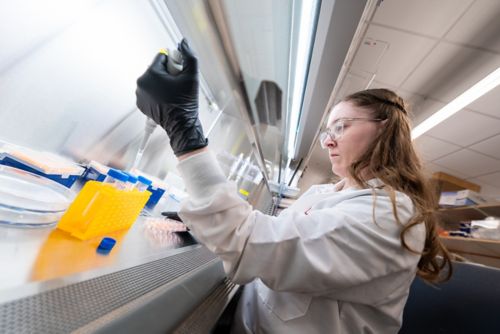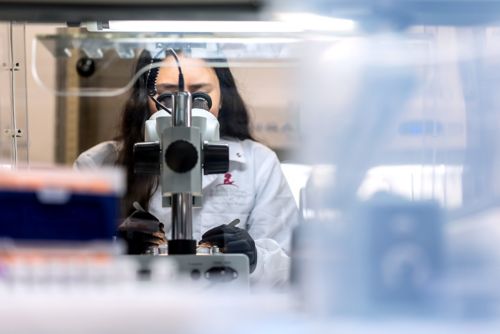St. Jude Family of Websites
Explore our cutting edge research, world-class patient care, career opportunities and more.
St. Jude Children's Research Hospital Home

- Fundraising
St. Jude Family of Websites
Explore our cutting edge research, world-class patient care, career opportunities and more.
St. Jude Children's Research Hospital Home

- Fundraising
About the Vevea Lab
Neurons are postmitotic cells crucial for cell-to-cell signaling in the brain. Over time and in the course of disease, these neurons gradually breakdown and become dysfunctional. This leads to neurodegenerative diseases, cognitive decline and dementia. Our lab is dedicated to understanding how neurons maintain their function. We are interested in understanding the complexities of the synaptic vesicle cycle, organelle function and how these processes are sustained throughout an organism’s lifespan. To answer these fundamental neurodevelopmental questions, we apply our own novel techniques, along with advanced microscopy, cutting edge biochemistry and protein engineering. Our goal is to ultimately learn more about aging and neurodegenerative conditions and develop potential future therapeutic approaches.

Our research summary
Our research concentrates on the fundamental mechanisms of synaptic function in neurons. Our group is particularly interested in the synaptic vesicle (SV) cycle and how membrane, metabolite and protein trafficking occur within the presynaptic area. The SV cycle encompasses some of the fastest membrane trafficking events in a cell. It consists of neurotransmitter-filled vesicles merging with the plasma membrane, the release of neurotransmitters, endocytosis of the vesicle, merging with early endosomes and finally, reformation as a functional SV. Some of these steps happen within thousandths of a second and repeat thousands of times every hour throughout a lifetime. We seek deeper understanding of this process, especially because signs of dysfunction in the SV cycle are seen early in aging and neurodegenerative diseases.

Synaptic vesicle cycle
The SV cycle deteriorates with age and disease, particularly in neurodegenerative conditions like Parkinson's disease, which contributes to cognitive decline and dementia. Decades of research have focused on understanding the molecular function of presynaptic proteins and identifying additional proteins that may play a role in neurodegeneration. However, we still do not understand how most of these proteins interact and function, both in healthy neurons and in disease.
To better understand the function of proteins at the presynapse, we apply a novel technique called knockoff. This approach allows us to disrupt a chosen protein by directly targeting it with a protease. This direct approach is pivotal as many presynaptic proteins have a long lifespan, making conventional genetic-based disruption techniques – such as acute CRE/flox or knockdown with shRNA – ineffective due to their inability to disrupt the half-lives of pre-existing proteins. Knockoff removes a protein of interest from a mature presynaptic compartment within hours. This rapid disruption grants us a clearer view of the protein’s function since the neuron and synapse cannot compensate for the protein’s loss.

Organelle quality control and polarity
In addition to studying individual presynaptic proteins, we also aim to understand how entire organelles, such as mitochondria and the endolysosomal system, contribute to presynaptic function. Additionally, we are interested in understanding the relationship between the presynapse and the soma, the neuron’s biosynthetic center. Presynapses face a unique challenge – they must maintain function despite their considerable physical distance from the soma. The fact that most cellular resources are transported over this distance suggests there is coordination between the two, but our understanding of this is limited.
We also aim to understand how mitochondria navigate within the axon, how the soma recognizes when more cellular resources are needed and how the axon determines when dysfunctional organelles need to be trafficked back to the soma. To answer these important questions, we use multifunctional fluorophores to temporally label proteins for downstream applications like mass spectrometry. Our goal is to perform a comparative molecular analysis regarding development and quality control. This unique approach will help us understand the basic differences among these organelles, including their composition, changes during development and aging and alterations during disease.
Notably, neurons have an asymmetrical distribution of their cellular components. Using multifunctional fluorophores, biochemical methods, the knockoff technique and advanced microscopy, we are investigating how neurons determine the destiny of their cellular components.
Publications
Contact us
Jason D. Vevea, PhD
Assistant Member
Developmental Neurobiology
MS 323, Room M2413
St. Jude Children's Research Hospital
Follow Us

Memphis, TN, 38105-3678 USA GET DIRECTIONS